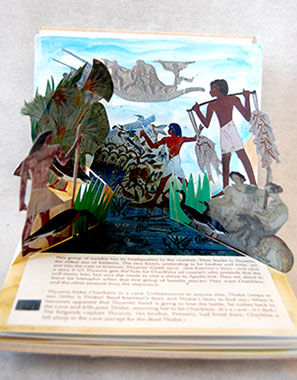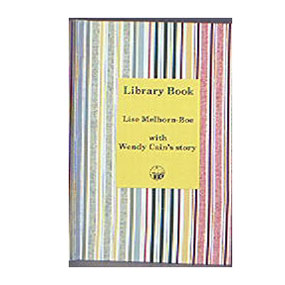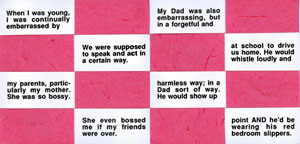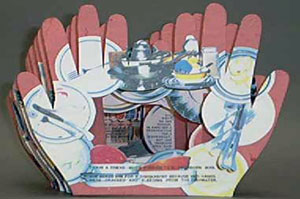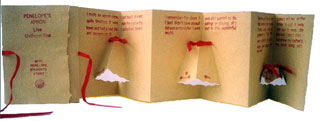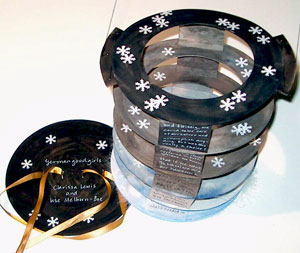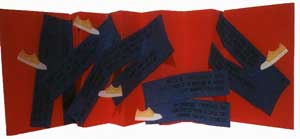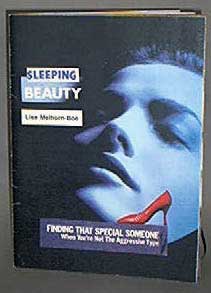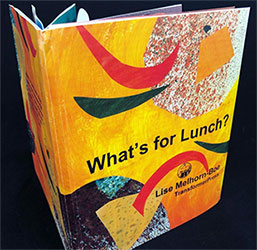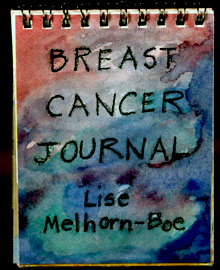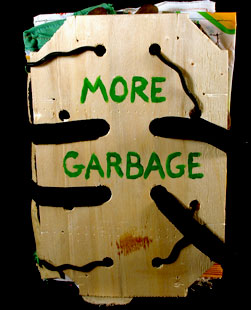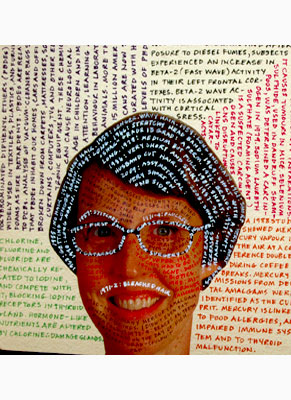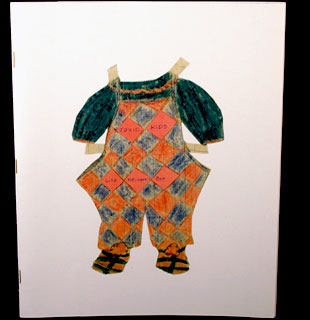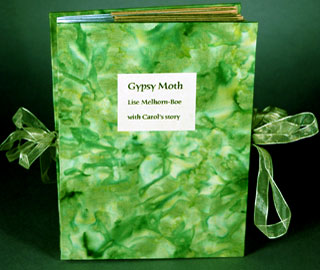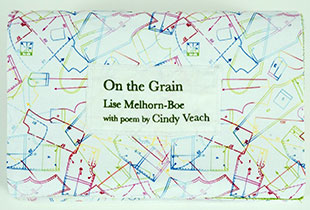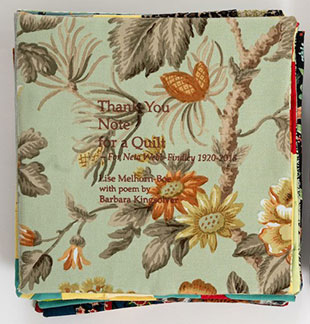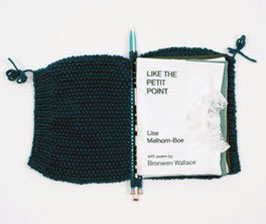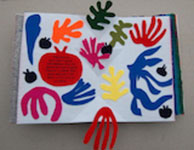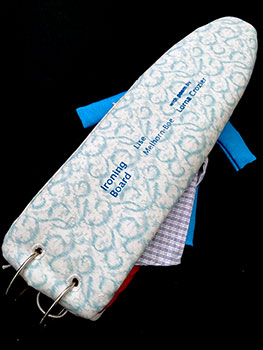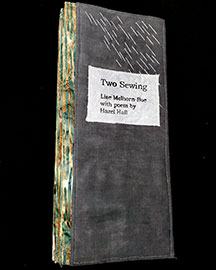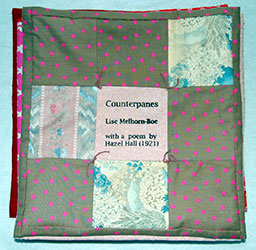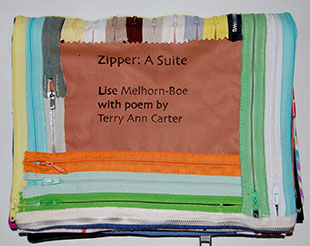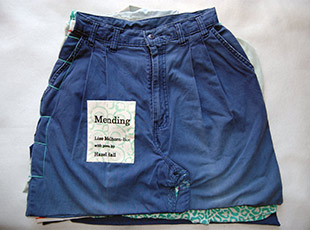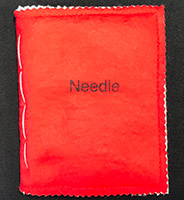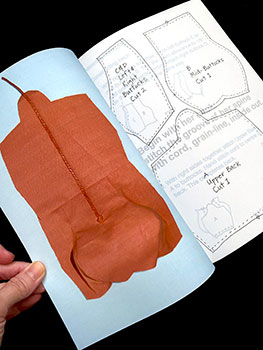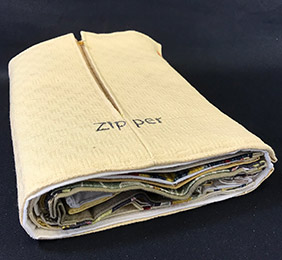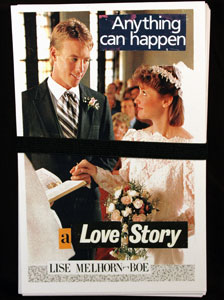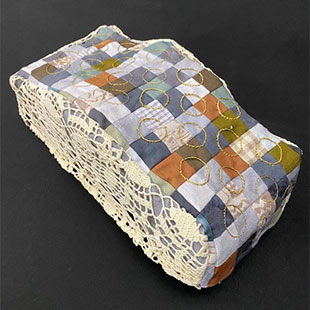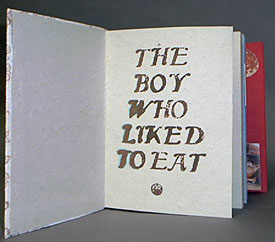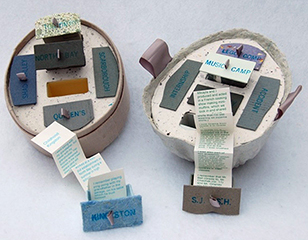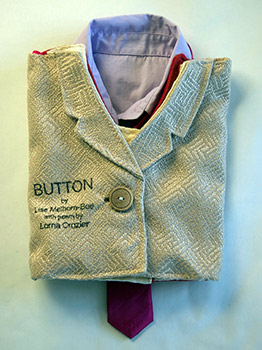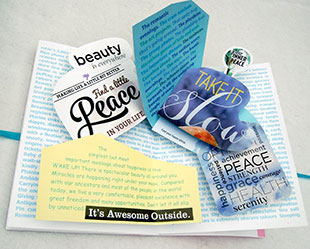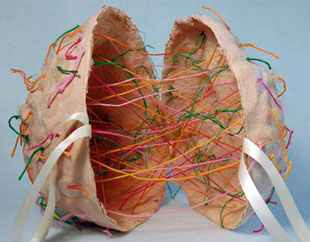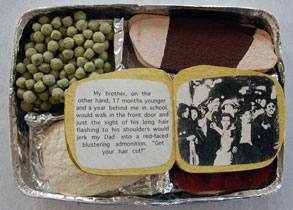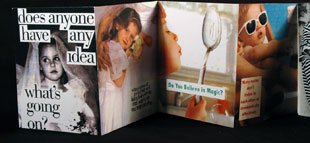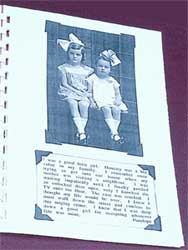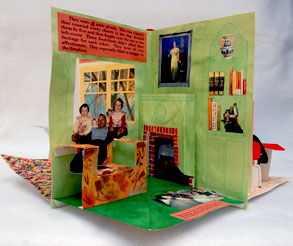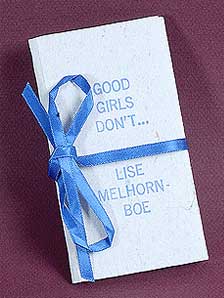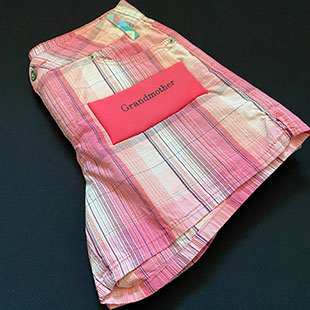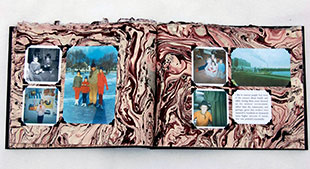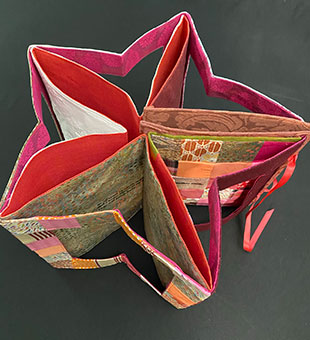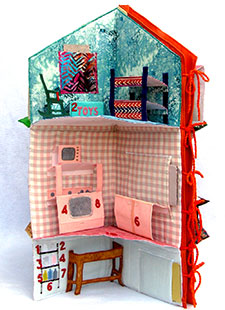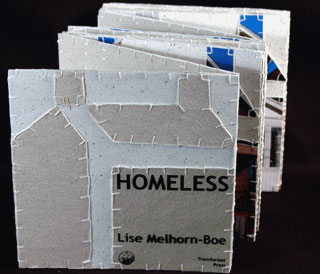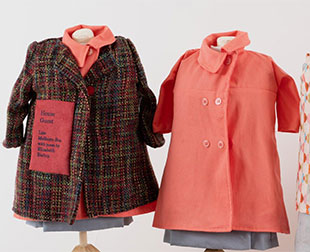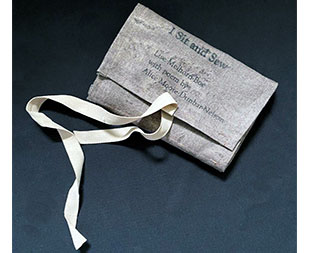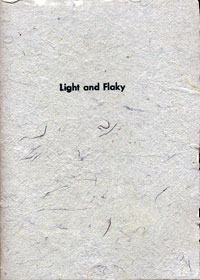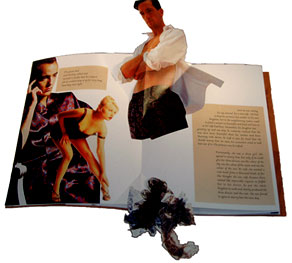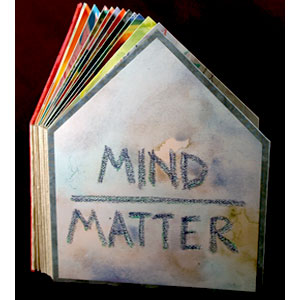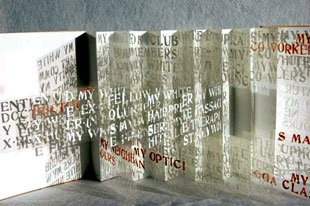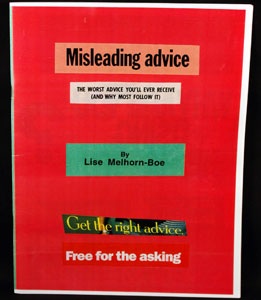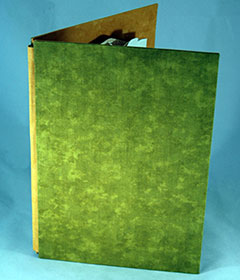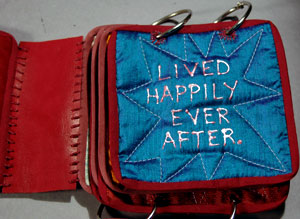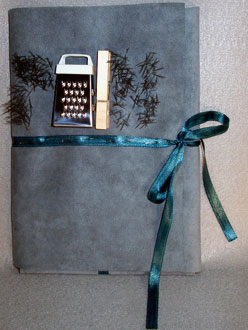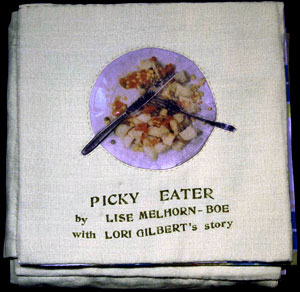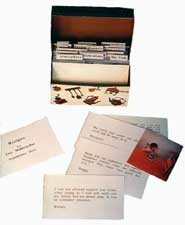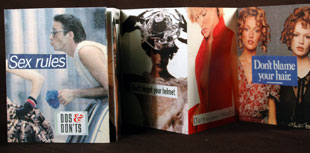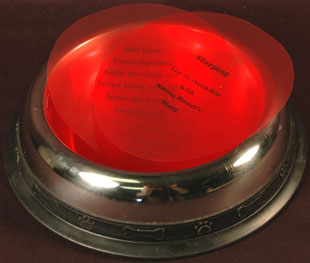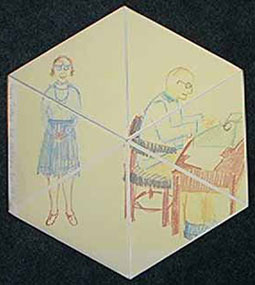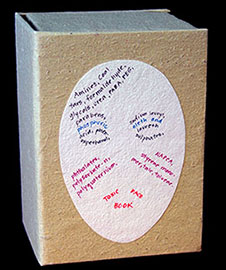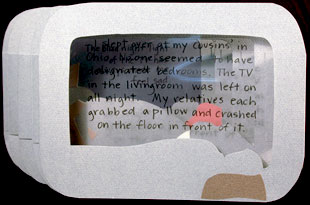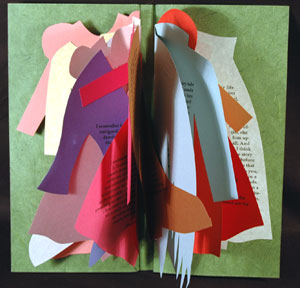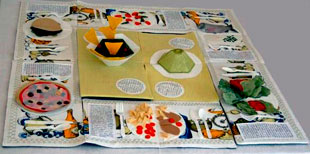
|
Transformer Press ~
Canada |
Share this page:
|
Duke University: "Melhorn-Boe’s work focuses on the experience of a diverse range of women whose stories she represents in unique interpretations of the book arts." “Con-nec-ton: Forty Years of Artist’s Books” a retrospective video of Lise Melhorn-Boe’s artist’s books. Created as a virtual gallery visit |
|
Fabric books by Lise Melhorn-Boe |
|
| Look Don't Touch A pop-up adaptation of Heliodorus' Aithiopika: Lust, Devious Plots, Intrigue and much more By Lise Melhorn-Boe Kingston, Ontario: Transformer Press, 2016. Edition of 10. 10.75 x 8.5"; 28 pages. 13 double page pop-ups. Color photocopied on 100 lb. acid-free card stock. Text printed in Optima, with titles in Delphian. Bound in cloth boards with paper title label on cover. Signed and numbered by the artist. Lise Melhorn-Boe: "Look, Don't Touch was inspired by The Aithiopika, a novel written by a Greek named Heliodorus, in 400 BCE The story takes place about 800 years earlier, in Kush (now northern Sudan/southern Egypt,) Egypt, and Greece. It's amazingly modern, with toy boys, and lots of lust, but there are storms at sea, pirates, bandits, and wars as well. I created the book as a commission for an exhibition, entitled Just One Look, at the University of Washington. The exhibition was curated to augment a conference on Classicism and Feminism. I really enjoyed the research - I learned a lot - and re-discovered the heart-stopping beauty of the drawings on Greek vases. Because the story has Greek, Kushite, Egyptian, and Persian characters, I culled my cast of characters from the pages of art history. It was a challenge to distill an entire novel into 13 pop-up pages - telling the story with added commentary – it could easily be a TV mini-series – Sex in the Classical City, maybe, or a 'western' set in the desert, with pirates, elephants and giraffes." Just Look, Exhibition Catalog: "If An Ethiopian Story can be compared to a cinematic epic, then Lise Melhorn-Boe, in Look, don’t touch, has matched its sensational and byzantine plot with dash and drama. The novel, with its subterfuge, romance and intrigue and its capacious cast of characters – Greeks, Persians, Egyptians and so-called Ethiopians (actually, as the artist learned, Kushites – inspired Melhorn-Boe to create a pop-up version of the tale using photocopies of actual artwork gleaned from those ancient civilizations combined with her original drawings and paintings. "With ingenious paper engineering, Melhorn-Boe captures the multi-layered narrative with an assemblage of overlapping images. In thirteen visually captivating pop-up scenes, … the artist delivers a veritable ensemble of cultural and artistic diversity. Melhorn-Boe deconstructs and reassembles Heliodorus’ timeline, thus providing the modern reader a clear path through this novel. "The deft combination of figures and objects sets up a shallow spatial progression that intensifies the relationship of one individual figure to another. Melhorn-Boe accompanies each scene with an insouciant interpretation of the labyrinthine tale and, like a rogue member of a Greek chorus, parenthetically adds wry commentary such as, I think we know where this is going.” $700 |
|
Library Book 8.5 x 5.5" with 4 pages. Bound in colorful striped cloth. Includes three double page pop-ups and one pull tab pop-up. Wendy Cain tells an amusing story about how she came to read all of Andrew Lang's Colour Fairy Books. Her Mother had died and the family moved into the city near a library. When she visited the library the librarian asked her what kind of books she liked. The librarian led her to the section of fairy tales. Cain visited this section for several weeks before an observant librarian introduced her to other book shelves in the library. Thus, began Cain's life of books. |
|
| Lise Melhorn-Boe is continually exploring relationships, especially family interactions - mother / daughter, father / daughter, sibling. In this explorations, she sometimes carries us beyond today, generally backwards in time to discover perhaps influences on our families from those past, hidden lives. | |
History Repeats Itself 5.5 x 3", 8 pages, a magic wallet book, photocopied on Ecosource Prf-21 55lb. hemp-flax-cotton Cover, with pink handmade paper inserts. "Magic Wallets" have a hidden text behind the visible one. Sarah relates a couple of stories about being embarrassed by her parents and then realizes that she and her husband aren't perfect either. |
|
A Good Wife Wouldn't 8.5 x 10.25" with 6 pages. Lise Melhorn-Boe on the origin of this book: "This story about a woman who wants a dishwasher, but whose husband won't let her buy one, even with a prescription from her doctor, and money from his parents, was told to me by Danielle Hart. It's a tunnel book made of pink handmade paper hands with colour-copied images of dirty dishes, washed dishes in a drainer and a dishwasher at the end of the tunnel." |
|
Penelope's Apron 7 x 5" with four spreads. Made of sickly yellow handmade flax-linen paper with red rubber-stamped text and flowers augmenting the four simple pop-up aprons. Laid- in same paper wrapper with red ribbon tie. A poignant story of thwarted creativity and conforming to parental expectations of how a good little girl should behave. It begins with the making of an apron from a yellow tea towel and red ribbon but as families and relationships go the apron becomes an item of irritation. The mother's anger becomes part of the "fabric" of the apron. So that finally Penelope puts it away - "I don't think I ever picked it up again." Lise Melhorn-Boe: "Penelope Stewart is an artist who lives in Toronto. ... she graciously shared this story, having answered my questionnaire. I have always been touched and honored by the stories women share with me." |
|
| Lise Melhorn-Boe looks at the social constructions formed on assumptions of what constitutes desirable feminine qualities. | |
Germangoodgirls 7" circular book tunnel book. Constructed of Artist Bristol Board and Kizuki Kozo. Hand-colored with Windsor-Newton watercolors. Tied with satin ribbon. Text handwritten with Staedtler Gel Roller and Faber-Castell Pitt artist pen. Add on of goose down. Snowflakes hand-punched from Kozo paper. Germangoodgirls was created for A Book Art Mosaic, a project of the Canadian Bookbinders and Book Artists Guild. Lise Melhorn-Boe: "The reference to the Brothers Grimm fairy tale Frau Holle (sometimes called Mother Hulda in English) led us to create a tunnel book that opens like a well. In the fairy tale, when Frau Holle, who lives at the bottom of a well, shakes her feather bed, it snows on earth, hence the addition of the feathers and snowflakes. Does the blue at the bottom of the well represent the water or the sky?"
$500 |
|
Rough Girls 11 x 7.75 x 1.5" 5 pages, a handmade paper flag book with a hard cover. Christine Charette's story about beating up boys in Grade Two is rubber-stamped on miniature blue jeans, which tumble across the accordion spine with tiny running shoes kicking here and there. “It never would have occurred to me to kick boys in the crotch when I was in Grade Two.” |
|
Sleeping Beauty: 7.75 x 10.5" accordion fold with ten pages. Each double page with a moveable / pop-up structure. Created using text and images from popular magazines and Canon Laser colour copied on 55-lb. Pro-21 Eco-source paper. No spinning wheels in this up-dated version of the well known story — it's a stiletto heel that puts this Beauty to sleep. Images and text are collaged from fashion magazines.
|
|
| Lise is currently researching connections between our health and the environment for a new body of bookworks. | |
| What's for Lunch? By Lise Melhorn-Boe Kingston, Ontario: Transformer Press, 2011. Open Edition. 7 x 8"; 10 pages. Flutter book. Pop-ups. Color photo-copied onto Boise HDP Color Copy Cover acid free paper. Numbered and signed by the artist. Transformer Press: "A fun faux children's pop-up book about (yes! more) toxins in our food. Color photocopied from hand-painted and collaged illustrations, with a bouncy poem as text. "My tummy is growling. What's for Lunch? Colourful illustrations combine with bouncy rhymes about nasty stuff in our food to make one wonder if having lunch is such a good idea." Lise Melhorn-Boe: "[What's for Lunch? is] sort of a companion piece for 'What's for Dinner?' in that it is also a pop-up book and also about toxins in our food. This one is however, more typical, in that it is made of paper. It is styled like a kids' pop-up book with a bouncy verse about the nasties we are eating. I actually designed it years ago for a contest that Little Simon advertised. Artists were supposed to illustrate, write and do the paper engineering for a pop-up book for 4-8 yr. olds. The winner was to be published, but no one won. I realized that I should take advantage of the fact that I had already done the artwork and pop-up design and just rewrote the text." $400 |
|
Breast Cancer Journal
|
|
More Garbage 8.75 x 12.25 x 2.5"; 20 pages. Found objects. Text pages stitched to various fabric pages. Text photocopied on acid-free cardstock. Bound with tapes and closures from knapsacks. Lise Melhorn-Boe: "This book is entirely made of garbage, or stuff I had lying about. No new materials were purchased except the photocopying of pages. The covers are bottoms of mandarin boxes collected at Christmas. The socks and T-shirts were worn out ones raided from husband and son and self. The mitts and gloves were picked up on the streets as the snow melted. ... The paper was left over from Wake up the Frog and Library Book. The thread was from when I used to do embroidery. The 'tapes' on which the pages are bound are mostly from knapsacks. The fake suede is leftover from the blinds I made when we moved into this house; also the insulation from other Roman shades. The rag rugs were from my mother's .... "It was fun to make these books, which are all somewhat different, of course, although it is an edition of 12. ""The text deals with the effect of garbage on our health." Bibliography:
$400 (Last Copy) |
|
Body Map 8 x 8"; 10 unnumbered leaves in a snake-fold format. Printed by an Epson Stylus Pro 9600 with the Ultrachrome Inkset onto Inkpress Fine Art Matte paper. Lise Melhorn-Boe: "I have been struggling with my health since my mid-twenties, some problems caused by or exacerbated by art materials, and discovered a couple of years ago that I had breast cancer. I then learned that I had extremely high levels of heavy metals in my body, which my doctor attributed to growing up in two communities with smelters. He also felt that the cancer and my chronic infection could be attributed to the heavy metals contamination. I realize that there are probably many others, whose health has been compromised in some way by their environment. I decided to make a body of work on this topic, and have recently spent four months researching connections between health and the environment, as an Artist in Residence at Queen’s University." Body Map is a show-and-tell book presenting some of the information that Lise has uncovered in her research about connections between our health and the environment. These tidbits of data surround a body - Lise's body.
$200 |
|
Toxic Kids 8.5 x 11"; 18 unnumbered pages. Photocopied on acid-free Boise HDP Color Copy and Color Copy cover. Another bookwork featuring Lise Melhorn-Boe's research into connections between health and the environment. In conducting her research she prepared a questionnaire which included questions about childhood environments. Lise Melhorn-Boe, Questionnaire: Tell me about your childhood. In what kind of environment did you grow up? For example, did you live near an electrical transformer or transmission line? in or near an agricultural/industrial area? near a gas station, print shop, dry-cleaning establishment? Was there a lot of tension in your family? This young girl's paper doll book incorporates information uncovered in her research: certain articles of clothing hold information, hand-printed by the artist, that specifically relates to connections between childhood environments and adult health.
$50 |
|
Gypsy Moth 6.375 x 8.75"; 10 pages. Set in Humana Serif and printed on an Epson Stylus Photo RX600 printer. Canal paper (peat moss and mustard flax) made by Papeterie St-Armand. Bound in green leafy cloth with green ribbon ties at both spine and foredges so it can become a two-dimensional carousel structure. Netting covers some openings; others have insect-like bodies hanging it them. Paper title on front cover. That misfortune is often underserved and beyond our control is no surprising revelation. When the situation is compounded by supposed experts who are supposed to help, it becomes even more infuriation. This is a story of triumph over such misfortune and attendant human folly and foibles. Gypsy Moth is a complex story — a true story — told simply. Carol was the unwitting victim of insecticide spraying. Her health suddenly took a nosedive. Doctors were wrong, pessimistic, and dismissive. She lost her job. Nevertheless, with the help of family, friends, nature, and her own spirit, she recovered. |
|
| Lise Melhorn-Boe is a seamstress making window coverings, cushions, slip covers, and of course books. | |
On the Grain 7.5 x 11.25 x 3” fabric book. Accordion structure. Pop-ups. Screen-printed text. Cotton with one piece of woolen fabric. Signed and numbered by the artist. Lise Melhorn-Boe: "Text is a poem by Cindy Veach, from her book entitled ‘Gloved Against the Blood.’ The poems explore the relationships of four generations of women against a backdrop of the textile mills of Lowell, Massachusetts. As someone who struggled with sewing a lot of my own clothes as a teenager, this poem about being an impatient learner resonated with me. It was fun to deliberately mess up the sewing, mis-matching patterns and bunching up seams. The last verse speaks of a piece of fabric woven by her Mémé, her great-grandmother in a textile mill in Lowell. A friend had recently given me a piece of woolen fabric woven in a similar textile mill in Almonte, not too far from where I live. There was just enough to cut into ten pieces, one for each copy of the book." |
|
Thank You Note for a Quilt Textile book of 16 patches: 9" square closed, extends to a yard square. Meander construction. Screen printed. Set in Book Antiqua. Multi-color fabrics. Signed and numbered by the artist. Lise Melhorn-Boe: "Thank-You Note for a Quilt’ is a meander book, made up with pieced fabric pages, which open in a spiral to form a 16-patch quilt in a Falling Leaves pattern. The poem, by Barbara Kingsolver, is dedicated to her friend Neta Webb-Findley, who taught Kingsolver to quilt. The text speaks about living on a piece of land for one's whole life, and sharing skills and friendship with neighbors. "As with many of the books in this series about needlework, the text is screen-printed on fabric, in an eccentric edition of 9. I also screen-printed some of the fabric, like the pieces upon which the first verse is printed. "I have relearned that it is a mistake to try to piece fabrics of different weights in a quilt, especially velvet. I did know this but wanted to use fabric I already had, left-overs from other projects, rather than buying new fabric. Much of the fabric came from my stash, which was augmented recently when a woman I know asked me to go to her deceased mother's house and take as much of HER fabric stash as I wanted. And another friend brought back some interesting printed fabrics from Indonesia and shared them with friends. “Permission to use the poem was granted by HarperCollins Publishers.” |
|
Like the Petit Point 8.5 x 11” with knitting needles extending length of spine. 10 cloth pages. Materials: knitting needles, yarn, cotton threads, sewing needle, recycled material from clothing. Screen printing on linen and cotton. Floral petit point on canvas. Cover of knitted (acrylic) by the artist with binding of knitting needles. Signed and numbered by the artist. Lise Melhorn-Boe: “’Like the Petit Point’ is a poem written by the Canadian poet Bronwen Wallace. Wallace was born in Kingston and lived and worked in Windsor and Kingston. She was an advocate for women's rights who focused her work on feminist issues surrounding domestic violence and sexual discrimination. Wallace was only in her forties when she died of cancer. The poem had not been published before appearing in ‘The Collected Poems of Bronwen Wallace’ edited by Carolyn Smart. This poem was used with the permission of McGill-University Press.”
“Like the Petit Point” is one of Wallace’s poems dealing with nostalgia and memory. Wendy Snideman in “Feminist nostalgia for healing and strength: mnemonic sites and signs in Bronwen Wallace’s poetry and prose” states -
www.liquisearch.com (04.27/2022): “Bronwen Wallace (26 May 1945 – 25 August 1989) was a Canadian poet and short story writer. Wallace was born in Kingston, Ontario. She attended Queen's University, Kingston (B.A. 1967, M.A. 1969). In 1970, she moved to Windsor, Ontario, where she founded a women's bookstore and became active in working class and women's activist groups. In 1977, she returned to Kingston, where she worked at a women's shelter and taught at St. Lawrence College and Queen's. She wrote a weekly column for the Kingston Whig-Standard. In 1988, she was writer-in-residence at the University of Western Ontario. “Her collections testify to her social activism involving women's rights, civil rights, and social policy. A primary focus of her work was violence against women and children.” |
|
Scissors 9 x 13 x 2.25"; 4 double pages. Pop-outs. Paper cutting. Materials: commercial wool and acrylic felt, felted wool sweaters, Flexi Firm, Stiff Stuff, Yupo, buckram, non-woven interfacing, tulle, acrylic paint, thread, glass beads and acid-free PVA glue. Screen printed with Colour Vie Textile inks. Screens made with a Thermofax machine. Numbered and signed by the artist. Lise Melhorn-Boe: "Lorna Crozier's poem moves us from aging to the magic of Matisse’s cut-outs and paper snowflakes and back again to death, in only four pages. Crozier bowls us over. This fabric pop-up book incorporates heavy industrial felt, pieces of a felted and dyed winter coat (thanks to Alana Kapell) and felted wool sweaters, as well as thinner felt and Yupo, a stiff paper-like plastic that can be stitched through."
$800 |
|
Ironing Board 4.5 x 15 x 2.25"; 3 plywood ironing board shaped leaves; 4 pages of text plus cover and colophon. Ironing boards covered with fabric with added enhancements of doll sized clothes. Text screen-printed on cotton or linen fabrics. Signed and numbered by the artist. Lise Melhorn-Boe: "Each copy of this book is different, as I was using up fabric from my stash during the third Covid 19 pandemic lockdown. The fabrics are colour-coordinated. I had a wonderful time making the little shirts, dresses, pants and skirts—I used a YouTube video to learn how to make pleats. It took me back to my childhood when I made a lot of doll clothes. I did order the teeny tiny buttons online." The text by Lorna Crozier is one of her odes to an unlikely candidate for literary celebration. Of the ironing board she says "There’s no harm in it, the ironing board. It’s pared down to bare essentials, simply a level surface with two flat feet to stand on. It must be put away after every use. If not, things pile up — books, stacks of paper, wet mitts, a shirt with buttons missing, milk cartons that need to be recycled, nail clippers for a cat.” |
|
Two Sewing 14" x 7" x 3" fabric flag book with stiffening inside the cotton and linen fabrics with a synthetic brown. Screen-printed text. Hand-embroidered items: rain, flowers and grass. Machine and hand-stitched. Lise Melhorn-Boe: "Hazel Hall's poem 'Two Sewing' animates this flag book. The lovely text refers to the wind as an embroiderer and the rain as needles, so Hedi Kyle's flag book seemed like an excellent structure to give the feeling of a landscape opening out."
(Last Copy) |
|
Counterpanes 12 x 12" closed, opens to 36 x 36"; 9 panels with 9 panes within. Materials: quilting fabric scraps, thread. Screen printed text. Signed and numbered by the artist. Lise Melhorn-Boe: "Counterpanes is a meander book that opens out to resemble a quilt, with nine-patch squares. These fabric books were screen-printed in an eccentric edition of 10 … using up drawers-full of quilting fabric scraps. For the edition of 10, I cut over 900 4.5” squares. There is one book in reds, and there are four in oranges, three in purples and two in greens." Four of the middle patches in four of the panels contain a poem by Hazel Hall. "Hazel Hall lived in Portland, Oregon, in the early 20th century. She was confined to the upper floor of her family home, where she took in sewing to augment the family's income, and wrote poetry. At least 35 of her poems are directly about sewing; many others use sewing imagery to describe her world." |
|
Zipper: A Suite 8.75 x 11.75 x 2" fabric book. Screen-printed text. Materials: fabric of different types and colors; zippers; thread. Handpainted second page is reproduction of painting by Canadian artist Sharon Thompson. Signed and numbered by Lise Melhorn-Boe. Lise Melhorn-Boe: "The poem in this book was written by Terry Ann Carter, a British Columbia poet, who visited Kingston to teach a haiku workshop (she is president of the Canadian Haiku organization) and happened to come into the store where I work. It transpired that she is a fellow member of CBBAG. I gave her my URL and the next morning, she phoned and asked if she could come to my studio to see my work She knows Lorna Crozier, and was delighted with ‘Zipper'.. A couple of weeks later, she emailed me this suite of poems, the first of which starts out in my living room, with a painting by Sharon Thompson." |
|
Mending Dimension varies according to size of pants for back and front covers; textile pages. Screen printed. Found and donated garments. Sewn binding. Signed, dated, and numbered by the artist. Lise Melhorn-Boe: "The text of 'Mending' is a poem by the American poet Hazel Hall. Hall was born in 1886, and lived for most of her life in Portland, Oregon. Following a bout of Scarlet Fever, at the age of 12, she was confined to a wheelchair. Hall took in sewing to help with the family finances, and 'Mending' is one of thirty-three poems she wrote about needlework. "The cover of each copy of the book is a pair of pants, or shorts. The first page is a collared shirt, the second a piece of household textile. Next follows a nightgown or pair of pyjama pants, and the last page is a T-shirt. Most of the garments came from friends and family." |
|
Needle 4.5 x 5.75"; 14 pages. Materials: fabric, needles, thread. Screen-printed. Typeset in Helvetica font. Bound in red felt covers. Signed, numbered and dated by the artist. Lise Melhorn-Boe: "Needle is a small fabric pamphlet, designed to look like a needle case, with real needles in it. ... The text is a poem of the same name by Lorna Crozier." $300 (Last 3 copies) |
|
Sewing Pattern 10 x 7.25"; 17 pages. Printed on Canson Infinity Rag paper, rag vellum and several types of acid-free card-stock. Sewn binding. Signed and numbered by the artist. Lise Melhorn-Boe: "I have wanted to make a book with sewing patterns for many years, so was delighted to discover Alexandra Cussons's poem, used with her permission. The poem describes the creation of a woman, who then destroys the pattern to maintain her uniqueness. Cussons is a British poet who won the Poetry Society's Foyle Young Poet of the Year Award in 2011 for this poem. The text of the poem is layered with pattern pieces, hand-illustrated sewing instructions, photos of the body parts and the final figure." The artist has mingled the three verses of the poem with pattern pieces and assembly instructions. She has also included images of each of the sewn pieces and then the final sewing project.
$275 |
|
Zipper 8 x 10"; 5 double pages, each with zipper in middle. Materials: zippers, fabric, thread, buttons. Screen printed. Cloth covers. Signed and numbered by the artist. Produced as a companion piece to an earlier book "Button." Both books were inspired by poems by Canadian poet Lorna Crozier. Zipper must be unzipped to read the text. As the title indicates the poem and book are about the characteristics of a zipper – its uses and connotations. Zippers are "sexiest on the back of a dress a woman can’t do up on her own. She lifts the hair on her neck and arches her back while someone behind her slowly pulls the metal tag up over vertebra after vertebra to the top.” |
|
| Transformer Press Sold and/or Out of Print Titles: |
|
Anything Can Happen: 5.5 x 8.5"; 100 pages (50 unbound leaves). Printed on both sides with images and text clippings from a variety of magazines. Images collaged and photo-copied. Shuffle book structure (unbound), but held together with black elastic band. Of the edition 1 - 99 produced in 1989 in black and white on cardstock, while 101 -150 produced in 2010 photocopied in colour on Boise HDP Color Copy Cover (80 lb.). Lise Melhorn-Boe: "Anything Can Happen is a shuffle book, in which the reader can arrange and rearrange the pages to create any number of stories about male/female relationships in the late twentieth century. The images and text are appropriated from men's and women's fashion magazines." |
|
Aunt 15" long 5" high 7" wide. Screen printed. Lucida Bright bold font. Automobile structure made of industrial wool felt and needle-felted wheels. Materials: cloth, wool, buttons, felt, textiles, plastic. Sewn cloth cover over automobile structure. Housed in gray box. Signed and numbered by the artist. Lise Melhorn-Boe: "This felt book resembles a car, a 1970 Buick Electra, to be exact. The poem, by Kingston, Ontario area poet Diane Dawber, refers to an old Buick; she also refers to her aunt as an angel. I chose the Electra, because I thought it sounded like a good name for an angel. The hood of the car opens to reveal the text of the poem, screen-printed on fabric. The trunk opens to reveal the colophon. There are found textiles, acetate windows and embroidered details. The wheels are needle-felted." "Aunt" by poet Diane Dawber was published in 1984. Dawber earned a Master of Education degree from Queen’s University. She has written children’s books and books on health as well as poetry.
(SOLD/Out of Print) |
|
The Boy Who Liked to Eat 10 x 7.5" with eight spreads. Accordion book with handmade paper pages and hard covers. The text is rubber-stamped and the images colour-copied. There are five very simple pop-ups. Tall tales and (possibly) true stories told to Lise Melhorn-Boe as a child are combined to create a fairy-tale version of her father's immigration to Canada, presented as a quest for food. The pages get more colourful and dimensional as the story progresses. Lise Melhorn Boe: "My father grew up during World War I in Germany, the third youngest of nine. So he remembered not having enough to eat. He was a good storyteller, so I've just put together a number of his tales. The photos are all really of him and his family. It was very hand that my grandfather actually was a poor shoemaker with many children, considering that I was trying to make it like a fairy tale. When I was away from home at university My father would always ask "Are you getting enough to eat?" (I was in a residence with an all-you-can-eat mean plan!) After my mother died, I would phone him and ask "Are you getting enough to eat?" |
|
| Brain Drawers By Lise Melhorn-Boe Kingston, Ontario: Transformer Press, 2015. Edition of 3. 6 x 6 x 8"; two parts. Top half cast-paper brain with 5 drawers – two glued shut, 3 with accordion books inside. Bottom half bound in cloth with 6 drawers – 1 glued shut, 5 with accordion books inside. Ribbon pulls on drawers with books. Signed and numbered by the artist on the bottom. In April of 2008 returning to his home in Toronto the artist's son lost contrail of his car on a ramp and hit a rock cut. Although he had on his seatbelt and the airbag deployed, his head was whipped into the support between the front and back windows, and he suffered multiple fractures. After a piece of bone was cut from his skull to remove a blood clot, he was put in an induced coma for five days. Lise Melhorn-Boe: "Brain Drawers a companion to Diffuse Axonal Injury, using the same brain mould. When Matthias came out of the coma, he mentioned a few times that he knew some information was in his brain, but 'that drawer won't open.' “Some drawers, such as ACCIDENT and INTERNSHIP, which he was doing when he had the accident, have no drawer pulls and are glued shut. Others, such as LEGO COMPETITION open and have memories of that occasion or place. These were longer-term memories that he had no trouble accessing. It was the stuff that had happened within the year before his accident.” (SOLD/Out of Print) |
|
Button 9.5 x 14.5" fabric book constructed as a vest with tie and shirt. Screen-printed text on fabric remnants and used shirts. Numbered. Signed by the artist. Lise Melhorn-Boe: "Inspired by the poem of the same name by Lorna Crozier, BUTTON must be unbuttoned to read the text. The fabric books were screen-printed in an eccentric edition of 10 in 2018. The buttons came from the collections of Norma Homer, Pauline Melhorn, and Reta Boe, with some of the lip buttons donated by Christine Howe. "An Officer of the Order of Canada, Lorna Crozier has been acknowledged for her contributions to Canadian literature, her teaching, and her mentoring with five honourary doctorates, most recently from McGill and Simon Fraser Universities. Her books have received numerous national awards, including the Governor-General's Award for Poetry. The Globe and Mail declared The Book of Marvels: A Compendium of Everyday Things, the collection from which comes the poem, Button, one of its Top 100 Books of the Year, and Amazon chose her memoir as one of the 100 books you should read in your lifetime. A Professor Emerita at the University of Victoria, she has performed for Queen Elizabeth II and has read her poetry, which has been translated into several languages, on every continent except Antarctica. Her latest book, What the Soul Doesn't Want, was nominated for the 2017 Governor General's Award for Poetry. She lives on Vancouver Island with writer Patrick Lane and two cats who love to garden." |
|
| Choose Happy By Lise Melhorn-Boe Kingston, Ontario: Transformer Press, 2015. Edition of 10. 8 x 10.75"; 10 pages. Accordion structure. Pop-ups. Paper wraps with ribbon closure. Signed, numbered, and dated by the artist. Lise Melhorn-Boe: "Creating CHOOSE HAPPY was an intriguing diversion. I was asked to create a book using the Artist's Book Ideation Cards developed by Barbara Tetenbaum and Julie Chen. One chooses one of each of the category cards, plus five adjectives, and then creates a work of art that fits the criteria. One can ignore two of the adjectives, and change one of the other cards, if desired. The cards I drew were Found TEXT, Muted or pastel COLOURS, LAYOUT across the folds, Self-generated IMAGE, Multiple colours of PAPER, TECHNIQUE of my choice, Accordion STRUCTURE. The five adjective cards were Elegant or harmonious, Textured, Scientific or research-based, Opposing or contrasting, and Loud. "Just the day before I drew the cards, I had seen, in Toronto, two billboards for Koodo Mobile. They spelled (in balloons) CHOOSE HAPPY. I searched for more found text in a variety of magazines. I then tried typing CHOOSE HAPPY in the search box of the public library's catalogue, and came up with How We Choose to Be Happy: The 9 Choices of Extremely Happy People-Their Secrets, Their Stories by Rick Foster and Greg Hicks. Searching for that on the shelves led me to HAPPY AT LAST: The Thinking Person's Guide to Finding Joy by Richard O'Connor, M.S.W., Ph.D and reading that led me to 14,000 things to be happy about by Barbara Kipfer. I have used text from all of these in 'CHOOSE HAPPY'. "HAPPY AT LAST was the most interesting to me. O'Connor references recent research on brain plasticity (a topic I have explored as I have a son who has had a brain injury) and posits that, just as the brain of stroke victims and people with brain injuries can be reprogrammed and create new neural connections, so too can anyone reprogram his or her own brain to be happier. O'Connor's text became the linchpin upon which the rest of the random texts could hang. "Since I had to make an accordion, and work across the folds, I decided to make a pop-up book. (Also because pop-ups make people happy.) I decided to make the text blocks become the pops and these sculptural pop-ups themselves became the 'self-generated images'." (SOLD/Out of Print) |
|
| Diffuse Axonal Injury By Lise Melhorn-Boe Kingston, Ontario: Transformer Press, 2014. Edition of 5. 6 x 8 x 6" paper object. Materials: cast paper, thread, ribbon, acetate. In April of 2008 the artist's son had an automobile accident when he was returning to his home in Toronto. On a sharply curving ramp he lost control of the car and hit a rock cut. Although he had his seatbelt on and the airbag deployed, his head was whipped sideways into the support between the front and back windows. He suffered multiple fractures. A piece of bone was removed from his skull in order to remove a blood clot. He was put in an induced coma for five days. Lise Melhorn-Boe: "This cast paper brain is filled with neural connections, but some are broken, owing to a nasty run-in with a rock cut. The acetate circles on the outside make me think about all the EEGs that my son has had since his accident. "I have to cast [part] one at a time, and it's cold, so the pulp dries slowly: This is a wordless portrait of my son's brain right after his accident." (SOLD/Out of Print) |
|
| Dinner for Three with Marilyn Zimmerman's story North Bay, Ontario: Transformer Press, 1998. Edition of 3. 10.25 x 7.5 x 1.5" box with 4 part aluminum tray containing 4 paper food items and a booklet. Materials: aluminum, paper. Images and text typeset in Helvetica and photocopied on Ecosource 60 lb. Eco-21 paper, 40% hemp, 40% flax, and 20% cotton. Food items made of cast paper. Pamphlet: 3.75 x 4", 10 pages; handmade paper; sewn binding. Box closure with slip-in flap. Lise Melhorn-Boe: "Safely nested between her parents on the couch, eating TV dinners, Marilyn Zimmerman contrasts her suburban life with the violent events on the television in 1968. An aluminum TV dinner tray holds cast paper food and a handmade paper pamphlet, all enclosed in a box. Colour and black-and-white photo-copies images are used on the box and in the pamphlet." (SOLD/Out of Print) |
|
does anyone have an idea what's going on? 4 x 5.25"; 16 pages. Accordion fold. Collage created using text and images from popular magazines. Collage colour-copied on hemp-cotton-flax cardstock. Lise Melhorn-Boe: "Statements and questions lead to answers which lead to more questions about women's sexual relationships as presented in women's fashion magazines." |
|
Family Album 8.5 x 5.5" 12 pages. Text and family photos are photocopied on Hemp/cereal straw paper with pink Kuratani end papers and pink handmade cotton paper covers with plastic comb binding. Lise Melhorn-Boe: "I had decided to explore the socialization of little girls and so wrote a questionnaire asking about being a good girl, or not, and sent it out to the women on my list - this wasn't the first questionnaire. So the stories come from a number of women but I chose to use photos of girls in my own family. I remembered how we used to get black and white photos in little booklets with the plastic "coils" so that's why I bound it that way." |
|
| The Family that Liked to Eat By Lise Melhorn-Boe North Bay, Ontario: Transformer Press, 1998. Edition of 3. 8 x 11.25" closed; 8 pages. Carousel structure. Pop ups. Constructed from Ecohemp 89 lb cover from Ecosource Paper. Painted with watercolors. Photo images and text color-copied on Tree Free Eco-21 Paper (40% hemp, 40% flax, 20% cotton). Typeset: New Century Schoolbook. Illustrated boards. Tie closures. Caroline Langill, Home/bodies: "Thoughts on Disclosure in the Recent Work of Lise Melhorn-Boe (Written in 1999 for the exhibition entitled Ghost Costumes at the White Water Gallery): "With this recent body of work, using the legacies left to her by her parents, Melhorn-Boe reveals the hidden lives of parents and children. So much of what happens in a family, as it struggles to maintain some semblance of normality, is invisible to the world. Pauline Melhorn produced a number of journals which expose a life fraught with tensions about missed opportunities, at a time when the notion of the nuclear family had reached its peak. "... The Family That Liked to Eat looks at the whole family and takes us back to a childhood full of middle class values. The adopted style mimics children’s literature. The pop-up format exploits infantile aesthetics in order to emphasize the irony of their ‘happy’ lives. By utilizing this form Melhorn-Boe locates us within the environment of her childhood. This canny strategy, to subvert our adult rationality through form, opens us up to the lives of this family from the point of view of the child/adult. "The colour xerox on the cover of The Family That Liked to Eat shows her [Pauline Melhorn] cheerily displaying a plate of mussels. It is not hard to imagine what drove her to involve herself in this subject to this extent, since we know full well that the body is a site of struggle for power within the family, but it is difficult to determine what drove her to write about it so, especially since it is clear through other writings, that she had other desires and needs outside of this realm of food. For this writer, this is how Pauline Melhorn has maintained her secrets—although the journals are now the property of her children, she has still managed to shield herself from them, to maintain her privacy, through a very cryptic text." (SOLD/Out of Print) |
|
Good Girls Don't 5.5 x 3" four spreads. Rubber-stamped text and colour photography transfer images on handmade linen paper, with four pop-ups. Accordion folded into a self-cover with a tab. Closed with a ribbon. Sunbonnet Sue pop-ups with the Virgin Mary superimposed upon them are surrounded by rules for good girls, such as "Good girls don't fight back" and "Good girls don't whine." Lise Melhorn-Boe: "When I first moved to North Bay 15 years ago, I took a quilt-making class specifically to learn to make a "log cabin" quilt. I had been saving fabric for it for some time. I got quite excited about the names of traditional patterns of quilts and made a series of them which related the pattern names to issues in contemporary women's lives. They were all multi-squared quilts, many with texts, so I just saw ("read") them as big flat books. I had my first show here exhibiting the quilts and several books that used quilt patterns as images, "Good Girls Don't" being one of them." |
|
Grandmother 11.5 x 14" closed, size dependent upon the shorts used and fabric. Madras shorts folded to produce cover. Cloth pages sewn from pieced bits of material. Screen printed. Signed and numbered by the artist. Transformer Press: "The poem was written by a friend of mine who lives in this area. Diane Dawber has written several books of poetry, along with some health-related non-fiction. "I asked Diane: 'What did you mean by suicide excuses?' She responded, 'My grandmother blamed my father for taking my mother, from the city (Toronto) to the uncivilized worlds of rural Northumberland County [thus] for my mother's suicide. Nothing to do with that, it was viral encephalitis. It is timely to be talking about loneliness and isolation now… and illness and dying, for that matter. Fear and anger, conspiracy theories, blame, hurt-as well as more positive emotions abound.' "The concept for this book came from a gift of two bags full of strip piecing that my friend Linda Coulter brought to a meeting of the textile group to which we both belong. She was moving studios and getting rid of stuff. As no one else wanted the fabric fragments, I grabbed them. I went home and opened the folder of poems I have been collecting and realized they would be perfect for this poem, which has to do with buying stuff at thrift stores and re-purposing it. I decided to use the pieced bits as pages. Some were quite large: others just fragments. I wanted something from a thrift shop for the covers, and thought of shorts as they are perfect to fold in half and are not too big. "I couldn't believe it when the first store I visited had many pairs of madras plaid or seersucker shorts which, although not 'vintage', looked as though they stepped out of my childhood. I had a wonderful time coordinating the pieced panels with the shorts. As in many of the books in this Sewing Poems series, this is an eccentric edition - each copy is quite different in colouration. " Text excerpt: "She was the one who shopped rummage sales/ for suicide excuses / but the cheap ones wouldn't do." |
|
Happy Memories 15 x 11"; 14 unnumbered leaves. Includes 44 photocopied snapshots of varying sizes on acid-free Boise HDP Color Copy Cover paper. Images and text attached to Indonesian marbled paper with acid-free photo corners. Signed and numbered by the artist on a business-card-sized slip attached to the last page. Opening a family photograph album for most of us probably is a mixed bag of memories — happy times, good times, sad times. Most things are never black-and-white (even though the photographs might be). In this bookwork Lise Melhorn-Boe, who has researched environmental health issues, looks back at her own family history in light of that research. Transformer Press: "Happy Memories uses the artist's family photos to illustrate Dr. Heather Jamieson's story of the relationship between growing up in a mining community and her current work studying environmental degradation caused by mining." |
|
Heavy Threads 8.5 x 10.75" closed. Textile book. Carousel structure with ribbon closure. Screen-printed on various hand-painted, upholstery and guilt-making fabrics, as well as embroidered table linens. Signed and numbered by the artist. Lise Melhorn-Boe: "I was drawn to this poem because it reminded me of an untitled poem my mother had written in 1983
“Hazel Hall's poem starts out with a window, so using the star carousel structure made sense to me, as it is a series of windows.
“I looked in my fabric stash for dawn-coloured fabrics and was excited to find the hand-painted fabric from my grad school days, used on the first window and the second background. This was partly because of the colours and the ribbon-like slashes (albeit teal, not a typical dawn colour) and also because the two pieces of fabric have seen an earlier life as Roman shades in my studio in North Bay. I didn't have an altar cloth, but I did have a set of finely-embroidered placemats and napkins. There were only seven. I did find something else I could use for three more, but then discovered that many of the other fabrics only provided enough for an edition of seven, so seven it is. "As with the other books in this series, the text is screen-printed with screens made on a Thermofax machine, a piece of out-dated technology which I hope lasts until I have finished the series." |
|
Home Sweet Home 38 x 12 x 3" with four spreads. Carousel format. Pop-ups. Fabric. Text handwritten. Includes bibliography. Signed and dated by the artist. Included for display are a set of Xeroxed booklets that replicate the information found in the booklets hidden in pockets on each page. Lise Melhorn-Boe: "Each of the 12 rooms in this quilted pop-up dollhouse-like book has toxins indicated by large red numbers. These correspond to information in booklets hidden in pockets on each page." Toxins in each booklet are color coded, for example, red for flammable material and orange for a corrosive substance. Heather Saunders, Harvesting Environmental Justice: "In viewing her environmental bookworks collectively, there is a disturbing sense of humanity being at risk from day one, evident in Endangered Species (2011), which features pink and blue onesies; Toxic Kids (2009), a paperdoll book; and Home Sweet Home (2009), a quilted dollhouse. Melhorn-Boe’s cautionary tales are often delivered with a wry sense of humour, rhyming couplets, and formats ranging from tunnel books to star carrousel books. These appealing features have a similar resonance as the stereotypical woman saying in a suspiciously enthusiastic tone, 'I’m fine.'" |
|
Homeless 7 x 7";15 pages. Accordion structure simulates a quilt by using the Little House quilt pattern to sew color photocopies of a row of solid-looking homes and sections of gray cotton paper handmade by the artist onto peat moss paper made by Papeterie St. Armand (Montreal). Color photocopies on Boise Fire 80 lb. acid free paper; text in Trebuchet MS Bold is black-and-white copy on acetate. Pages stitched together with cotton thread. The quilt pattern is central. Not only does it echo the quilt the artist was forced to sleep under because of the toxicity of her home but it also simulates the fragmentation experienced by the homeless. What seems solid is really stitched together in a tenuous way. Lise-Melhorn Boe: "In the fall of '06, I came across a disturbing statistic: according to a study from the Environmental Health Coalition of Western MA, 57% of people with Multiple Chemical Sensitivities have been homeless at one time or another. I thought "Whew! I'm lucky that I have a safe home," but by the fall of '07, my own house was making me sick, and by that winter, I had been forced to find a new place to work and was sleeping on our unheated front porch, with piles of quilts and a hot water bottle. I felt as if I were homeless. " |
|
House Guest 13 x 9 x 9" when closed. Screen printed on various fabrics. Materials: dressmaker’s dummy, cloth, wood. Poem used with permission from Farrar, Strauss and Giroux, taken from The Complete Poems 1927-1979. Signed and numbered by the artist. Lise Melhorn-Boe: "Elizabeth Bishop’s funny, yet poignant poem ‘House Guest’ is about a depressed seamstress. When questioned, she finally reveals that she would rather be a nun. The dressmaker’s Judy (dummy) is layered with five garments—all based on clothing from the 1960s, as that was the decade in which the poem was written. The first coat was made from fabric from a suit of my mother-in-law, which she wore in the 1960s. The second coat is a copy of a coat which was worn by Queen Elizabeth II. Removing each of the first four garments reveals a stanza or two screen-printed inside the clothing. The final verse is printed on the front of a 1960’s-era shorter nun’s habit. (The colophon is on the back.) “I learned to sew as a child and have often used textiles in my feminist artist’s books over the past forty plus years of my bookmaking career. ‘House Guest’ is the most recent book in a series in which I have been exploring various forms of needlework, using, as text, poetry which explores topics related to sewing, knitting, embroidery etc. as well as the tools used. In the past, I have always chosen a book structure that enhances and enlivens the text or subject matter I am exploring, but this recent work is allowing me to explore the use of textiles as a subject themselves. I am having a great time translating book structures which I have used in the past in paper (like pop-ups and flag books) but making them work in fabric. Sometimes this is a challenge as most textiles are not as stiff as paper. However, in ‘House Guest’, the fabric is treated as fabric—I sewed and stuffed the dressmaker’s Judys, then designed and sewed the clothing. The stands were made from pine newel posts and dowel.” |
|
I Sit and Sew 4.5 X 6.25 x 1"; 3 fold out pages. Pages sewn in fold cloth wrapper. Screen printed. Poem published in "Caroling Dusk: An Anthology of Verse by Negro Poets (1927)". Signed and numbered by the artist. Transformer Press: "Alice Moore Dunbar-Nelson's poem is in the voice of a woman, during WW1, who wishes she were doing something more active to help the soldiers, rather than sitting and sewing. The book's format is modelled on a WW1 'housewife,' a soldier's sewing kit. As it unfolds, the viewer will find sewing tools and eventually the text." |
|
| Light and Flaky Portrait of the Artist's Mother: A Cookbook by Lise Melhorn with story by Pauline Melhorn Wayne State University: Transformer Press, 1982. Edition of 190. 6.5 x 9"; 32 pages. Printed on Rising Parchment 100% rag paper. Pamphlet bound with cover paper handmade from linen and cotton tea towels, tablecloths, aprons, and dish cloths. Exhibition catalog, Women Writing and Reading, Bruce Peel Special Collections Library from May-August, 2007: "Melhorn-Boe's bookworks deal in various ways with women's issues, often with humour and a strong sense of irony. Melhorn-Boe's mother, Pauline Melhorn, was a painter who encouraged her daughter's early interest in creative arts. By her own account, Melhorn-Boe 'bullied her mother into writing' Light and Flaky. This memoir/recipe book begins with Pauline Melhorn's childhood, tracing her development as a cook through marriage and motherhood. It is interspersed with recipes and family photographs and maintains a humorous tone throughout." Although Light and Flaky may be personal history, it will hit strike a chord with anyone who has cooked - the rollercoaster of finding one's own way in the kitchen. The main course is the spirit of fun, exploration, and practical reality that wafts throughout. The recipes are simply gravy. (Sold/Out of Print) |
|
Many-Fur 10.5 x 8.25"; 13 pages with six pop-ups. Accordion structure. Bound in patterned cloth with fashion magazine illustration and paper title on front board. Colophon on back pastedown. Uses illustrations from fashion magazines. Text computer typeset in Lucida Calligraphy. Printed using a Xerox Colour Series 50 photocopies on Rolland Hitech acid-free 80 lb. paper. Many-Fur (Allerleirau in German) was one of the fairy tales collected by the Brothers Grimm. Perrault collected a similar story known as Donkeyskin (Peau d'Ane in French.) As it involves incest, it has fallen out of modern collections for children. Lise Melhorn-Boe: "Because it is a less-well-known fairy tale, probably because of the implied incest, I chose to actually include the entire story as the text, rather than using words and phrases from the women's magazines as I did with the other four fairy tales." |
|
| Mind over Matter By Lise Melhorn-Boe North Bay, Ontario, Canada: Transformer Press, 2010. Edition of 10. 9 x 11.25 x 1.5"; 12 leaves. Accordion structure. House shaped boards and pages. Printed by an Epson Stylus Pro 9600 with the Ultrachrome inkset onto Crane Museo Max and ink press fiber papers. Cotton-covered acid-free board covers with spine of Le Papeterie St. Armand's canal paper (sisal coffee). Lise Melhorn-Boe: "Some of a series of watercolours I painted when my old house was making me sick. These images were supposed to fool my mind into believing that all was well, although the first image pretty much portrays how I was feeling. ... The images portray a journey from despondency to a joyful wellness, as the artist tried to visualize herself better." (SOLD/Out of Print) |
|
| My (Discouragingly) White Life By Lise Melhorn-Boe Kingston, Ontario: Transformer Press, 2014. Edition of 6. 6.5 x 9"; 7 leaves. Flag book structure with 21 flags. Text rubber-stamped with Speedball Block-printing ink onto acetate. Uses Inkpress Fine Art Matte Paper for the accordion and Tibetan Straw Paper on the board covers. Colophon printed on Ecosource Paper's hemp, flax, and cotton paper (Tree free Eco-21.) Signed and numbered on the colophon by the artist. Lise Melhorn-Boe, colophon: "In the book Learning to be White: Money, Race and God in America, the author, Thandeka, writes: 'African Americans have learned to use a racial language to describe themselves and others. Euro-Americans also have learned a pervasive racial language. But in their racial lexicon, their own racial group becomes the great unsaid.' "As a means of becoming aware of this racialization process, she suggests playing the Race Game. It has only one rule: for a week, one must use the term white whenever one mentions the name of a person of European descent. For example, one might say, ' my white friend Beth, or 'my white son Matthias.' Out of this exercise came this book." (SOLD/Out of Print) |
|
Misleading advice 8.5 x 11"; 23 pages. Magazine format. Color photocopied on Domtar Plainfield Offset paper. Saddle stitch (staple) binding. The titles of articles in women's magazines promise heaps of insider wisdom. Lise Melhorn-Boe: "Women’s magazines are chock-full of advice—this handy volume wastes no space on articles but gives you nothing but advice on everything from “Eight things never to say to the man you love” to “Ten ways to make yourself miserable.”
|
|
| No Safe Levels By Lise Melhorn-Boe North Bay, Canada: Transformer Press, 2006. Edition of 3, State II. 6.5 x 9.9" closed accordion with pop-outs. Photocopied on acid free paper. Laid in cloth covered boards with interior corner pocket for book to slip into. Signed and numbered by the artist. Transformer Press: "Northern Ontario highways are lined with rock cuts, sometimes covered with graffiti. This pop-up rock cut morphs into the artist’s scarred body." Lise Melhorn-Boe, interview with Cassandra Kuyvenhoven from "The Garbage-loving Environmentalist": "This is a rock cut because I love the rock cuts along the highways up north. People do often put graffiti on the rock cuts, so my graffiti on this ‘rock cut’ is all the heavy metals that are in my body and the size of the lead and mercury are much bigger because I had a much higher concentration of those than say, tin. "To visualize — this book is cut out in the shape of me lying down on my side, with my leg stretched out. It connects to the quote down at the bottom, which is: 'there is no separation. We are the environment. So whatever we do to the environment, we do to ourselves' and that’s David Suzuki. So I am part of these rocks, these rocks are a part of me. This is my personal landscape and it’s my body and its intersections with the environment, with nature, with rocks, with metals." (SOLD/Out of Print) |
|
Once Upon a Time 50 pot-holder style pages including title and colophon. 48 (5 x 5") squares with text on one side only. Closed 7.5" deep. Open 72" horizontally. Twelve 5 x 5" base pages bound with leather and bias-tape. 36 foldout pages attached with metal rings through embroidered holes in base pages. Techniques and materials: quilting, embroidery, cloth, leather, thread, metal rings, and fabric. An interactive work allowing the reader to create the tale within a multiple choice framework. The base line of the story begins: "Once there was a…." Choices ensue. Is the protagonist a CEO, police officer, pop star, environmentalist, computer geek, politician, or street person? Was s/he lazy? A workaholic? Very wise? Lise Melhorn-Boe: "To make this multiple choice fairy tale, I started with archetypical fairy tale characters and situations and then adapted them to a contemporary setting. I have been collecting fabrics and thinking about it for a long time. I actually have only the one copy completely finished, and another almost finished. The others I still have to write the text, quilt, bind and make the holes and embroider round them. There will be three others with the burgundy leather and bias-tape edge-binding, and four of them will have tan-coloured leather and tape." |
|
Pain 7 x 10"; 12 pages. Bound in stiff covers of marbled paper (by Luci Lapierre). Accordion structure with pop-ups. Printed on an Epson Stylus Photo RX 600 printer on Eco-Source Eco-21 cardstock (hemp, flax and cotton). Pop-ups mounted on St. Armand cotton rag paper. Font: Garage Shock. Laid in suede wrap with pins and needles sticking out. Ribbon closure attached to suede with pins. The subject is pain. Excerpts from Diane Dawber's Lifting the Bull: Back Pain, Fibromyalgia, and Environmental Illness offer first-person accounts of extreme pain. The pop-ups – jagged white on black – offer a visual metaphor. The pins/needles in the wraparound offer reader participation. Painful. |
|
Picky Eater 13.5 x 13.5"; 9 pages. Cloth book. Tablecloths have been cut, rubber-stamped, appliquéd with color-copy transfers and re-assembled to form a foldout book. This is quite actually a tablecloth book. Unfolded and draped over a table, the story of how one picky eater is disciplined can be read by moving from place to place. Lise Melhorn-Boe: "Lori Gilbert’s unpleasant memories of being forced to eat are combined with photos of a plate of food being mushed about and slowly consumed." |
|
Recipes 3 x 5" box containing 129 cards with dividers. Printed on hemp paper. Recycled metal recipe box. Signed and numbered by the artist. A recipe box that holds family photos and stories collected from twelve women about food and family relationships. Instead of Casseroles, Salads and Desserts, the categories become Atmosphere, Force-Feeding, Obsessions and Prohibitions. Tara Hyland-Russell, Fairy Tales and Family Fables: "Lise Melhorn-Boe recognizes that, as Mary Catherine Bateson phrases it, 'Women’s lives have always been grounded in the physical by the rhythms of their bodies and the giving and receiving of concrete and specific tokens of love, a ring or a teaspoon of cough syrup.' Thus Melhorn-Boe roots her bookworks and sculptures in the everyday objects and aspects of women’s lives: aprons, baby clothes, recipes, meals, houses, makeup and follows a trajectory that marks the undervalued objects of women’s lives as worthy of scrutiny. The resulting works have a potent visual, tactile and narrative appeal." |
|
Sex Rules: Dos and Don'ts 4 x 5.25"; 16 pages. Accordion fold. Collage created using text and images from popular magazines. Collage colour-copied onto hemp-cotton-flax cardstock. Lise Melhorn -Boe: "Illustrations from fashion magazines are paired with strange commands to create a bizarre little rule book for sex in the new millennium." |
|
Slurping 8.5" circular stainless steel dog bowl with six text pages laid in. This stainless steel dogfood dish holds red acetate pages printed with Norma Homer's funny story about eating jello, and a lesson learned about proper eating etiquette.
|
|
Someday 8 x 11 x 5" curved pink-and-white quilted-brocade covered box. Pearl button and gold braid closure. Six cutout text pages (including title page) and four quilted fabric illustrations loose in box. Text rubber-stamped on handmade paper. A Mother's story about the power of stereotypes – here the prince and princess – young girls are taught. She witnesses her three-year-old already identifying with strong men and weak women. The daughter insists upon acting the role of the princess who has to be saved. Mother fights back with feminist fairy tales. But the struggle is not easy. In the end Mother says, "My daughter has observed the world and has noticed that the boys are in charge. I do what I can. She is strong." Lise Melhorn-Boe: "The story of Someday came from Marilyn Zimmerman, who teaches photography at Wayne State University in Detroit, and who was one of the members of my MFA Committee. She's a good storyteller and I have used several of hers before." |
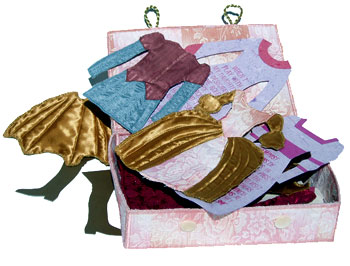 |
The Tale of the Teabags 5.5 x 8"; 10 pages. Double-sided accordion. Text rubber stamped onto handmade cotton paper. Accordion openings restricted by a thread, representing a clothesline from which hang "tea bags" simulated by color Xerox transfers. Laid in paper wrapper with ribbon closure. This is one father's theory of thrift and frugality. Or is it stinginess and tightfistedness? We can at least be thankful that the subject is teabags and not toilet paper. Lise Melhorn-Boe: "This is a funny tale about the philosophy of the cost of teabags relative to the price of cold beer and hard work according to the father of the writer, Lori Gilbert. The handmade paper pages are rubber-stamped with photo-transfer teabags on a 'clothesline,' and are shaped at the top to represent elements of the story." Text excerpt: "He points out that teabags are quite durable. They have substance; a lot of tea can be squeezed out of one little bag. He suggests that instead of two teabags per pot, from now on it will be two pots per teabag. And tea-drinking will occur only after a certain amount of housework has been accomplished. ..." |
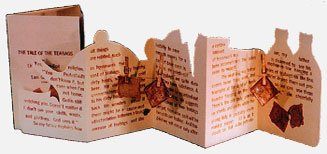 |
Three Sisters 10 x 8.5" three faces. Tri-hexaflexagon made of Arches cotton print paper with colour photocopies on Tree-free Eco-21 paper. Flex the flexagon to reveal three views of the same set of parents. Drawings by the artist and her two sisters (Margaret Melhorn and Marie Cooper). Lise Melhorn-Boe: "Years ago, during some "Reach for your inner-child-type workshop, I did a drawing of my parents. My husband was interested to note that I had drawn my father without ears. He actually had huge ears but was partially deaf. He had his back to my very worried-looking mother and was typing. My youngest sister happened to come to Toronto to visit me, and, without showing her my drawing, I gave her paper and coloured pencils and asked her to draw them. Hers was completely different except that my father was wearing the same blue sweatshirt! "Her" parents were standing side-by side and looked very happy. ... I wrote to my middle sister, ... and asked her to draw our parents in pencil crayons. The same blue sweatshirt appears again! It was perfect. It fit in between the other two drawings perfectly, making a progression from alienation to harmony. Three sisters with three different views." |
|
Toxic Face Book 6.75 x 4.75 x 3"; 12 leaves. Cast paper. Handwritten text. Laid in clamshell box. Lise Melhorn-Boe: "The cast-paper face/cover lifts off to reveal 12 pages of text about the toxicity of some ingredients of shampoo and cosmetics." Colour Me Dutiful was the precursor to Toxic Face Book. Melhorn-Boe recycles her work; that is, she will use the leftover pieces from previous projects as a basis for a new project. Colour Me Dutiful focused on stories of women on why they wear make-up and how it makes them feel. In Toxic Face Book she uses the face motif and cast paper, but her focus is on the chemicals that are used in the cosmetics that women use on their face. |
|
TV Blues 9 x 6.75" closed. Tunnel book. Lise Melhorn-Boe: "I am an artist who has been making books as art objects for over twenty-five years. I have often used other women’s stories as the inspiration and text for my work." Based on Robyn Mooney's story, this book speaks to the effect of a night spent in a home where the bed consisted of a pillow in front of the television. |
|
Wake Up the Frog 5.25 x 11.25"; 11 shaped pages (cut in the form of shoes or clothing). Computer typeset in Book Antiqua. Photocopied on Canson Mi-Tientes and Colour-Line acid free papers. Paper wrap with title cutout on front. Flutter binding. Eleven women write about the effect of fairy tales on their lives. Lori: "Something that affected my life was reading the original version of the Frog Prince. In this original, as in modern versions, the frog makes more and more demands for greater and greater intimacy with the princess. However, when he demands a kiss, instead of overcoming her revulsion and complying like a good girl, she defends her honour by picking him up and throwing him against the wall. And that is when he turns into a price. I think of all those little girls fed on the false story that 'you have to kiss a lot of frogs before you can find a prince.' The true story is that the only real prince is one who respects you, and that you can't bring out the prince in a guy by capitulating to his endless demands. Sometimes you have to wake up the frog in a big way before he leaves his slimy habits behind and learns to have respect for women." |
|
| What's for Dinner? By Lise Melhorn-Boe Kingston, Ontario: Transformer Press, 2011. Edition of 7. 10 x 10 x 5" closed, opens to 40" x 40"; 18 pages with eight 2-page pop-up spreads. Cover with title in felt letters that have been sewn onto printed fabric. Base constructed from found tablecloths. Each book is unique in that the tablecloths vary over the edition. Other materials: fabric swatches, various papers, plastic utensils. Transformer Press: "Food pops off plates on this tabletop-sized book made of tablecloths. The text about toxins in our food is hand-printed on the napkins. "Pesticides, antibiotics, growth hormones, and genetically-modified foods are some of the issues raised in What's for Dinner? Yum, yum!" The information, certainly meant as cautionary, begins from the first sentence – "Half of the produce currently tested in American grocery stores contains measurable residues of pesticides." (SOLD) |
|
WRONG! 12 x 6"; 4 pages. Text rubber-stamped on pink and blue handmade flax paper, folded to represent baby blankets. Pages intended to look like baby blankets folded around a baby. Bound with satin ribbon like that used to edge blankets. Melanie Egan's memory of an 5th grade Health class, when the teacher asked "How do you tell a girl baby from a boy baby?" is, perhaps, an amusing story now, but traumatic to a 10-year-old girl at the time. Lise Melhorn-Boe: "This story was told to me by a friend. She was almost in tears when she told it, even though it had happened at least twenty years earlier." |
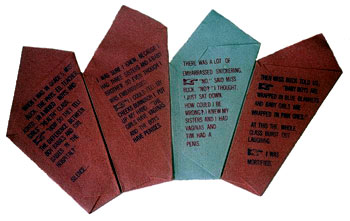 |
Page last update: 07.10.2025
Home | About Us | Contact Us | New Arrivals | Fine Press & Artists' Books | Broadsides |Resource Books | Order/Inquiry
Copyright © 2021 Vamp & Tramp, Booksellers, LLC. All rights reserved.
